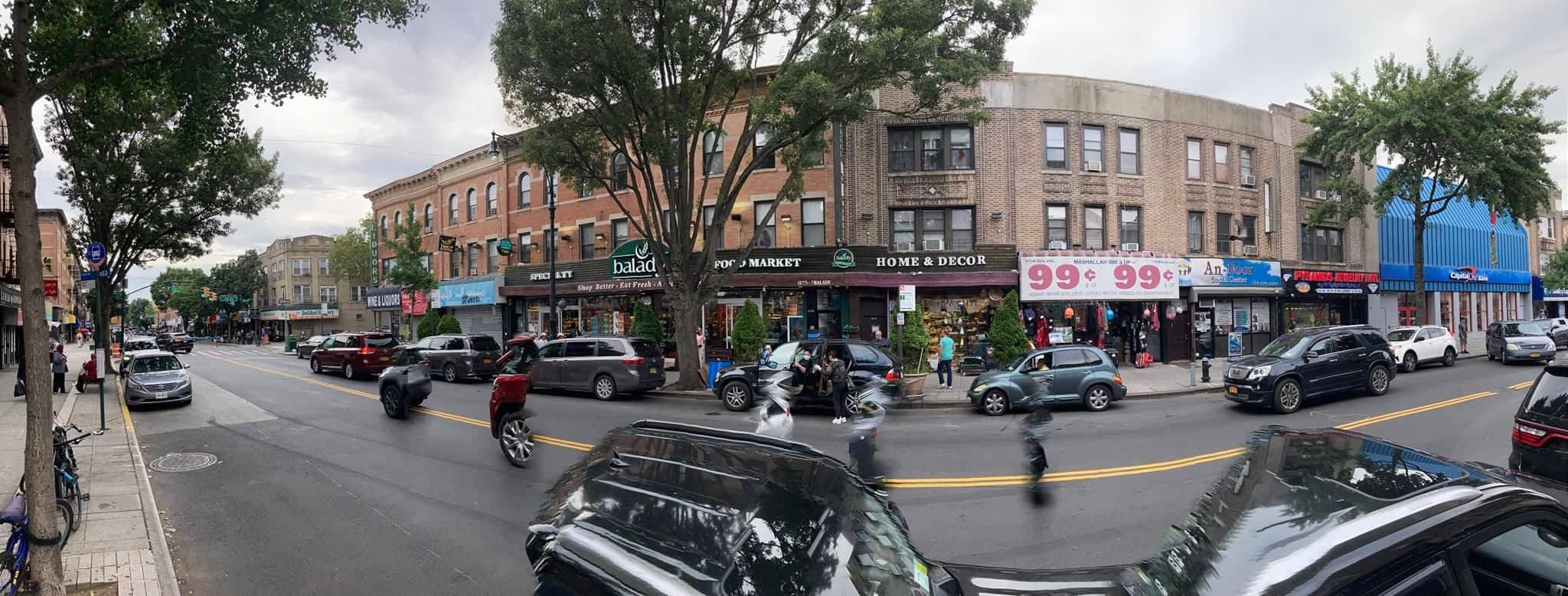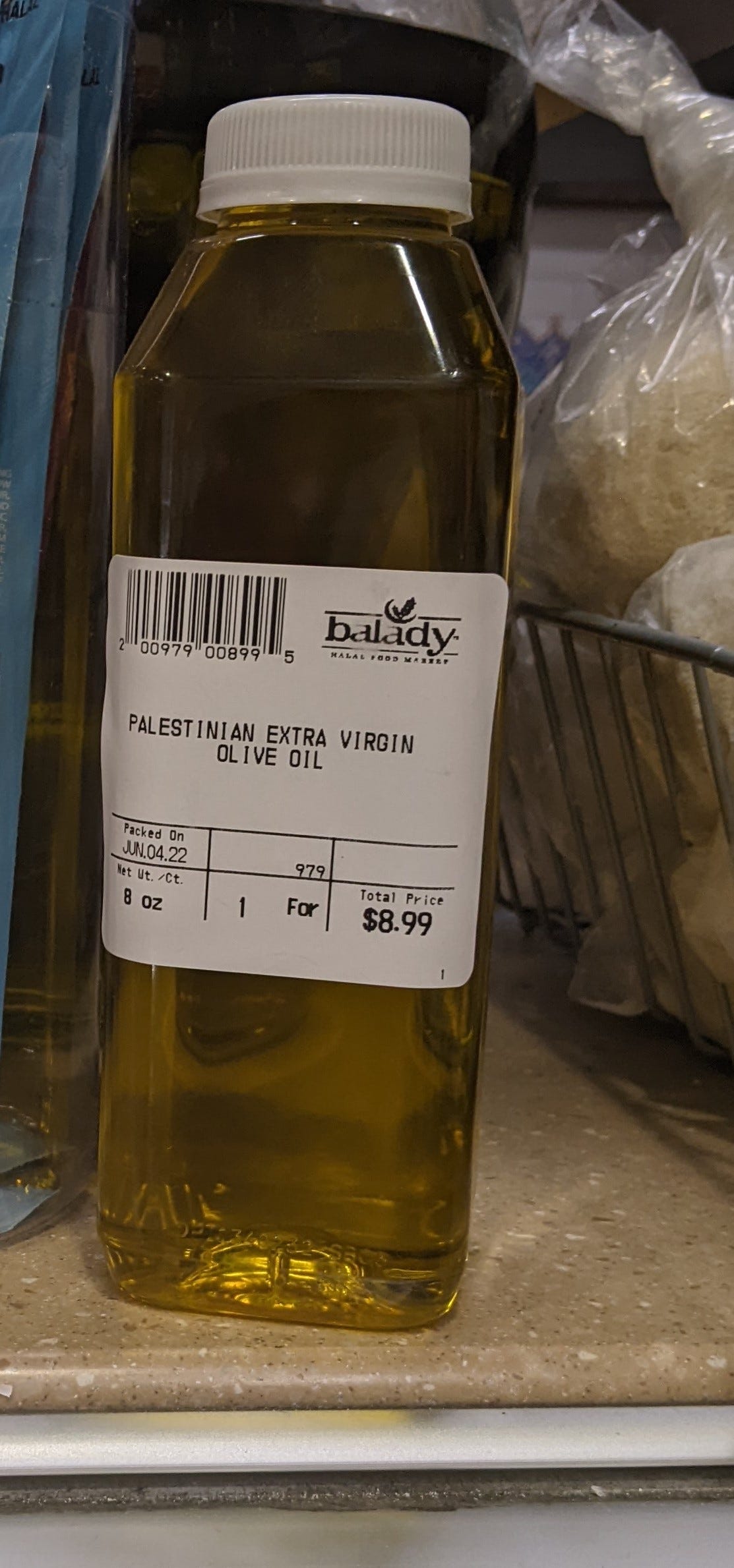Middle East Delights, Nasturtiums, and a Valiant Woman
Saturday News Digest, V1/E19
Table of Contents
Out and About on the Middle East Trail
A Most Audacious Woman
The Nasturtium Sandwich Search
Idea From the Innovation Dept.
Summer Reading Pleasure
Endearing Photo of the Week
Out and About on the Middle East Trail
Oil and honey
Here is what you do when you come to this particular Brooklyn neighborhood. You walk down the main shopping street to Balady, the biggest halal market in the city. You wander up and down the aisles picking up many items you know you don’t need but decide you want. Things like spices and grains scooped from bins and chicken from the old man behind the meat counter who asks if you want its feet on or off. There are freezer cases of quails and all kinds of meat dumplings, tables piled high with trays of baklava and almond pastries. Different types of bread from at least five Middle Eastern countries. Saffron-scented creams, long loofahs, perfumed essential oils, and boxes of different hennas are displayed at the end of aisle 4. Many of these go into your basket.
Of all the tall jammed shelves in the narrow aisles, the one that stops you cold is the one packed with olive oil. On the bottom two shelves are the usual ones from Spain and Greece, and two from California olives. But you train your eyes on all the other shelves crowded with bottles and tins whose labels are all in Arabic. You are very confused and excited!
The man watching you from behind the cheese counter takes pity and calls you over. Arranged on top of his counter are small bottles of rich gold oil. He’s quick to tell you the story of his family’s olive grove in Palestine. It has been in his family for centuries.
“My father says a thousand years, and he should know. My brother’s the one who guards the trees for his children now.”
He will pour a little of his family’s oil into a thimble-size paper cup and pass it over the counter. You sip—its earthy smell deepens the potent olive taste.
He will laugh at your astonished face. “Yes?” he says, and two bottles land in your basket.
Out the door you go to walk several blocks to a small café just opened by a couple from Yemen. It immediately became popular for its thick strong coffee—what someone you know has described as “real ‘hair on your chest’ stuff.”
The wife makes honeycomb bread, a specialty so sticky and sweet one bite is enough but never enough. Honey, a little card at the counter tells you, is one of the most legendary and treasured foods of Yemen. Since forever, nomads have followed the bloom of the Sidr trees with their beehives. It is processed pure, what we would call small batch, what the card says is tribal legend. The honey is especially valued for its medicinal attributes. If the woman’s honeycomb bread is an indication, it is beyond any honey you have tasted.
You tell the woman this and she takes down one of the small beautiful bottles for sale. She gives it to you. You say you want it.
“Eighty dollars for this,” she says. “But it’s cheaper if you buy the taller one. Two hundred dollars, but you have three times more and it will last forever.”
Heartbroken, you admit there’s no way in hell you can afford her honey.
She leans in closer as if to tell you a secret. “You will not know what you have ever done without it.”
You are even more heartbroken, but you have to comfort yourself with the woman’s honeycomb bread and the strong thick coffee.
A Most Audacious Woman
Diana KennedyMexican food in this country would have remained known for stiff, tasteless tacos and soggy refried beans if it wasn’t for the fierceness of Diana Kennedy. Through the 1960s, Kennedy traveled around Mexico in a passionate search for the recipes that define the complex nature of regional dishes, each the result of a long steep in the different regions’ ancient history and culture. The result was her first book, The Complete Book of Mexican Cooking, published in 1972 and immediately recognized for its transformational importance to Mexican cuisine.
Kennedy went on to write eight more books about Mexican food and one memoir, Nothing Fancy, about growing up in England. She died this week at age 99. May all culinary writers be so uncompromising in pursuing their hunger. And may we all—but especially women—have her guts and gumption to open our lives to discoveries all the way through to our last breath.
The Nasturtium Sandwich Search Two new friends
The title of the old book is forgotten in which a nasturtium leaf sandwich was wrapped up in wax paper and carried in a lady’s pocket for sustenance on a long walk. It didn’t give any hint of how the sandwich was made, but it sounded like something I might like to eat on a long walk. And so I discovered two delightful people on-line who knew several old nasturtium sandwich recipes.
I’m going to say with no intended hyperbole that Barry Enderwick may have eaten more historical sandwiches than anyone else on the planet. He makes them on YouTube, TikTok, Instagram, and Facebook for throngs of adoring people. Besides old sandwich recipes, he has a collection of beautiful shirts that someone would like to have, too. His first nasturtium recipe calls for anchovies. He didn’t much like it, so he made up one of his own.
My other friendly discovery was Erin O’Reilly’s blog, Convivial Supper. She explores an inviting array of recipes from old books and newspapers. She found her nasturtium recipe in a column called “Everyday Helps for Women” from a 1913 edition of The San Francisco Sunday Call.
My patch of nasturtium burned up in the summer heat, so I asked a neighbor for a few leaves from her hanging basket. I followed Enderwick’s first recipe, where the anchovies were smashed into a paste. I don’t know what his objection was; I thought the salty fishy taste paired nicely with the peppery nasturtium leaves. I also recommend making it on sourdough bread. The sandwich keeps very nicely in a tight fold of wax paper. It goes extremely well with a very cold beer, especially after a long walk.
Idea From the Innovation Dept.
Creative way to save on gas and electricityOne of our readers, Ruby, sent in the photo below over the weekend while the country was blazing hot—and in some corners actually blazing. Baking cookies using solar power is both economical and environmentally safe!
Directions: Mix up a batch of chocolate chip cookie dough, then drop tablespoon-sized scoops on an ungreased cookie sheet. Carry to your car and place directly on the dashboard, making sure the sheet is fully in the broiling sunlight. Timing depends on how unbearable it is outside. The photo below was taken in New Jersey, where the temperature over the weekend felt like 104 degrees. Under those conditions, one scientific calculation puts the interior of the car at about 147 degrees after one hour. Figure, then, the cookies would be ready in two hours or so, but go out and check on them from time to time. Once they’re baked to your satisfaction, be sure to use a pot holder to remove the sheet. Carry the sheet into an air-conditioned room or at least a shady area. Pour a nice cold drink and eat the cookies one by one.
Summer Reading Pleasure A fine virtual magazine store
Not so long ago there used to be small shops or kiosks overflowing with magazines and newspapers from around the globe. Often, they were very crowded to the point of bursting out onto the sidewalk with customers because people would stand about and read through many different publications. The vast array of knowledge and lifestyles from near and far that one could gleam was breathtaking. The world’s latest politics, fashion, gossip, literature, crosswords, games, crimes, scandals, science, pornography—right there in one convenient spot. Heaven on earth, but now almost as extinct as a dodo.
But now to the rescue comes The Sample, a virtual newsstand right in our little pockets. I heard about it from a friend several weeks ago, and it has proven an invaluable way to discover writers and subjects that I would have never found and read about. After you sign up and check off subjects that appeal to you, The Sample will begin to send you a weekly offering of independent writers and artists. If you find one you like, you can subscribe to it in a single click. Sign up here and get reading!
A handful I’ve found to be of interest, in no particular order:
Damn History —one restless historian with an opinion about everything.
Pipe Wrench —an online magazine that describes itself as “a dinner party where all the guests are really fucking sharp.”
Dinner Document—beautifully written short essays on food and life.
Night Water—full range of pop culture subjects distilled for those of us who are out of the loop, don’t really want to be, but like knowing what’s happening.
Both Are True —when you need to hang out with a hilarious weirdo.
Endearing Photo of the Week








